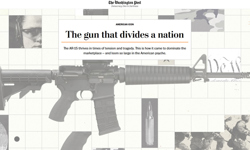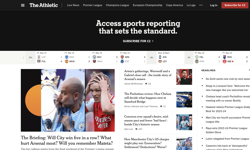An odd thing has happened. A black and white silent movie has just swept the board at the Oscars - the first time a silent film has won an Academy Award since the first ceremony in 1929.
This seems extraordinary in a world where movies can now dazzle us with the full 3D surround sound CGI high definition treatment in our own living rooms. Apparently content still counts for something after all.
The storyline of The Artist will also resonate with publishers who are battling to re-invent their offerings and their business models, as the matinee idol hero finds himself left behind by the new-fangled technology of talking pictures – falling on hard times before finally learning some new tricks himself.
But here’s the question which has had me scratching my head since I saw the movie a few weeks ago. It’s undoubtedly a great film. But is it really a triumph of content over form – or the other way round? It’s a film about form for a start. And would it have succeeded if it had been made in colour with sound?
In some ways, it’s another example of how the success of some content brands is inextricably linked to their format. Facebook, for example, can only really exist digitally. In print, it would just be an address book with a letters page, and a space for including your holiday snaps. As a live event, it would just be known as ‘having a social life’, and therefore unlikely to be valued in tens of billions.
Likewise, a non-digital version of Twitter would be like opening your window and shouting out random comments at passers-by (a surprisingly satisfying alternative, as it happens).
Other content brands are more elastic and have escaped the confines of their original form to exist on multiple platforms. The pace of change continues to accelerate, and newspaper and magazine publishers have had to widen both the scope of the content they offer and the way in which it is delivered, as their traditional business models have come under pressure.
As each new format emerges, they open up new possibilities – both for content creation and for making money. But the two don’t always go hand in hand.
Experimenting with new formats
A contact of mine recently recounted a conversation with the MD of a consumer magazine publisher in which he asked how the company’s gorgeous new magazine app was going. “It’s terrible”, came the unexpected reply. “Every time you turn the iPad on its side, the page changes completely. Even the photos change. It’s costing me a fortune – I have to pay someone to lay out every page twice but I don’t get any more money for it.”
Continual experimentation with new formats is inevitable if publishers are to keep up with their customers’ content preferences, and many editors have embraced the range of media they now have at their disposal with gusto. They and their teams have been working hard to develop both the volume and breadth of their output. Working practices have also evolved to encompass more timely delivery of news bulletins, and the production of video reports, podcasts and the use of social media.
But despite their enthusiasm to experiment with these new forms, some still do not seem to have a clear view of where their priorities should lie in marshalling often overstretched resources. What is the optimum number of news stories to generate per day? How many bulletins? Why a podcast rather than some other mechanism?
As I have argued throughout this series, formulating a successful content strategy means putting your audience at the heart of your business model. First you need to gain a deeper understanding of their content needs and consumption habits – only then can you set about producing the right mix of content to suit their needs.
The final piece of the jigsaw is delivery. How do you serve that content in the most appropriate format to maximise engagement and therefore value?
By assessing audience need first, then drawing up a content strategy to suit, we should find that answers to some of the knottier problems about formats and publishing models emerge naturally. Questions which at first seem to represent a fundamental shift or a gigantic leap of faith – such as whether a print title should change frequency or go online only; or whether to produce a magazine app – become more straightforward to resolve.
In the audience insight research that Red River Blue conducts on behalf of media owners, we have noticed some recurring themes – regardless of the subject matter or market sector.
1. People say they are swamped with information and content - much of it free. But despite this (or perhaps because of it) they place even greater store by those trusted sources that can help them to sift out the nuggets of ‘must have’ information.
2. They routinely use a variety of media formats on a daily, and even hourly basis. They have not automatically abandoned ‘old’ media as each successive format emerges, but they have changed how they use each of them. In many cases, print readership remains surprisingly resilient.
3. They will pay for the right content, delivered at the right time in the right format. And nine times out of ten, they are already paying for some content. Even in markets where the publisher is convinced that ‘people in our sector never pay for anything’, they usually do. (Although they may not always be willing to pay for what that publisher is currently producing.)
4. They will tend to pay the most for trusted content that they need (as opposed to ‘want’). This generally means content which is specialised (ie. not easily accessible elsewhere), useful (it helps them to perform a task, or save time in doing so, or confers some other tangible benefit), and of high quality (trusted and/or comprehensive).
So how do you decide what formats to use? One part of the answer lies in the content itself. For example, breaking news is evidently well suited to the instantaneous nature of digital and mobile delivery. Long form journalism, infographics or lush photography may be better suited to print, or perhaps tablet form. Database services are naturally suited to desktop delivery or an app. Meanwhile, educational or training content works well online as a broadcast or webinar, or as a live event.
The other part of the equation is how the audience prefers to receive it. Do they spend more time on mobile devices than sitting in front of a desktop? Is the information going to be used at work or at home (or on a train)?
Format agnostic
As publishers, we should be agnostic about how we deliver our content. The right answer is to deliver it in the way or ways that suits the content and works best for the audience. Because that it is the only way to deliver value.
In that sense, a publisher’s strongest asset is not a particular product or format, but the relationship with the community it serves. Or to put it another way, it’s not the content which you monetise – it’s the audience.
Selling content is no different to selling anything else. Give the customer something they need, at the right time, in the right format, and at the right price – and they will buy it.
To achieve this, sometimes one or more of the elements in the content and format mix will need to be changed. Sometimes they just need to be re-focused and re-packaged. So if people aren’t buying your content, or perhaps only willing to pay a little, ask yourself (or rather ask your audience) the following questions:
* Is it the right content?
* Is it packaged (and priced) correctly?
* Is it delivered at the right time and in the right way?
All three parts are needed for a successful content strategy. Producing compelling content is only part of the story – the format has to be fit for purpose too.
Otherwise you may end up like the taxi manufacturer who couldn’t understand why he was struggling to make any sales in one of Europe’s most popular cities for tourists. He reasoned that he had a great product that answered a clear customer need. But however good it was, the reality was that he was never likely to sell many black cabs in Venice.
And there is no reason to assume that you have to adopt a ‘one size fits all’ approach to charging for content either.
Each market will vary in its needs, but it is perfectly possible to conceive of high value subscriber services, one-off purchases, and gated areas of sites happily co-existing with high traffic generating free areas and other products funded by advertiser revenue. In fact, in many markets, the most likely outcome is a hybrid strategy which provides some free content (driving traffic) which is supported by ad revenue and a range of paid-for services.
This kind of approach maximises the potential revenues by tailoring the revenue model to the audience need and willingness to pay for the particular type of content being provided, rather than forcing the majority of content behind a subscription wall at a single price point, which may prove a barrier to further expansion of the community.
A multi-faceted approach like this requires something of a shift in old ways of thinking, however. Publishing has historically been a product-centric business. We publish magazines, we put on events, we build websites and apps. But to create a truly successful content strategy, we have to set the content free.
Audiences that routinely skip from format to format as part of their daily consumption habits aren’t really interested in amassing a collection of content products. They just want their information needs met – on whatever platform is most convenient for them at the point of need.
If we want to sell them more content, we therefore need to think in terms of increasing their engagement levels, regardless of medium. In a modern content strategy therefore, the overall content output of the brand is spread across multiple outlets / formats, each contributing something different to the overall brand experience.
Each manifestation of the brand can then be built on appropriate content which harnesses the power of that medium to maximum effect rather than trying to replicate the experience of another medium. A successful printed magazine, for example, will have content which works well in that format. So what’s the point of simply replicating that in, say, an app? It misses the point (and the opportunity) entirely.
This is not to say, however, that content cannot travel from one medium to another successfully. Indeed, one could argue that it is the knitting together and re-purposing of content in new ways to serve a variety of needs that can be one of the most powerful aspects of a well-constructed content strategy.
Life cycle of news
Let’s take a very basic item of content as an example - a news story. We’re used to thinking that news is cheap, or free. That it is commoditised, and outmoded thanks to Twitter etc. And that it has a very limited shelf-life – tomorrow’s chip paper as they used to say in the olden days (about five years ago).
So what’s the life cycle of a news story these days?
It might start life as a tweet, before being expanded for an email news bulletin or web update. Next it might be developed further into a longer news analysis piece in print or for a magazine app, or perhaps a video report. It could then be attached to a database listing about one of the protagonists, or archived as part of a ‘knowledge bank’.
Finally, its content may be dissected and recycled as part of a data service which is highlighting trends, or intelligently sifting real time information.
It is perfectly possible to see how the value of that piece of content can be exploited in different ways in each of those incarnations – across a variety of formats and price points, from free news snippets driving traffic (and therefore ad revenues) to paid-for apps, or as part of a premium information service.
Self-evidently, this means having a joined-up approach to the formats and products that you produce – both in terms of managing the content, but also in terms of packaging and pricing it accordingly.
It also means having a robust and joined up approach to customer data. This is not only to ensure effective cross-selling and improved service for existing customers, but as a way of gathering information about potential new customers (an email address here, a download there).
Capturing usage data, including information about customer journeys, is also vital. Understanding what content works and how they interact with it, enables you to refine your output and the usability of the product, and will inform future development and content pricing strategies. It’s also fundamental to developing effective ad-funded models.
So what makes a winning content strategy? Although there’s no magic bullet, a successful content strategy is likely to share many if not all of the following characteristics:
* Founded on deep understanding of audience’s content needs and format preferences.
* Delivering content which can flow freely between products, allowing appropriate packages to be created.
* Using intelligent taxonomy - allowing content to be shaped, sifted and re-purposed in multiple ways across different media.
* Based on a hybrid business model - with tiers of value in the content and the products from free to premium.
* Employing a customer-centric, rather than product-centric data model – enabling effective cross-selling and better customer service.
* Restless, adaptable and creative – continually experimenting with content, format and business model.
* Closely watching the user data – monitoring what works, what doesn’t, and what patterns emerge.
Furthermore, every content strategy will need to be continually re-visited, tested and adapted – all the time.
Looking back even just two or three years, it’s clear that the publishing industry has come a long way in a short space of time. In fact, it has evolved to the point where it is not even clear whether we still are publishers or whether we are content providers, broadcasters, curators, or ringmasters.
This period of transformation isn’t going to let up anytime soon and anyone who confidently tells you he or she knows how the landscape will look even in five years’ time is either a liar or a fool. The one thing we can continue to expect is more change.
In which case, how does any content-based business plan for the future?
My advice, for what it’s worth, is to stick close to your audience. Watch how they behave, listen to what they say. And continually adapt both what you do and how you do it, so that you give them what they want.
As Jean Dujardin’s character in The Artist realised – if the audience doesn’t want to hear you speak, then you’d better learn to tap dance.
Stephen’s ‘How to develop a winning content strategy’ series:
Part 1: Audience (Nov/Dec 2011)
Part 2: Content (Jan/Feb 2012)
Part 3: Format (Mar/Apr 2012)










